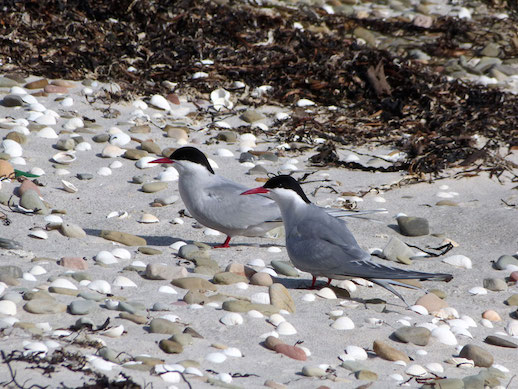 A pair of Arctic terns
A pair of Arctic terns
Words and pictures: Steve Sankey
At 59° north in the deep mid-winter it’s a good tactical ploy to think of summer. When the gales are reaping their relentless physical and mental toil on our bodies, but the sun is yet to catch up with our hopes and desires, it’s necessary to think of the spring and the promise that lies ahead.
It’s helpful to focus on our migratory birds, some of which, remarkably, will still be in the southern hemisphere as late as February. Take the Arctic tern, for example, which Orcadians onomatopæically call a tirrick. This phantom of elegance, all poetry across the sky, sees more daylight than any other creature on earth as it travels upwards of 45,000 miles each year. It’s not called the ‘bird of the sun’ by Greenlanders for nothing. It basically migrates from pole-to-pole twice a year, and our Orcadian birds spend their winter somewhere in the Southern Ocean, by-passing Australia and New Zealand to reach the Antarctic.
When back in Orkney, from late April onwards, these Arctic terns are a joy to behold. At once noisy, gregarious and gallus, they are also blessed with balletic flight and impeccable courtship manners. As such they are a Janus of a bird, exhibiting manic bipolar disorder in their avian world. Sadly their populations have declined seriously in Orkney, by as much as 90%, and gone are the days when it was physically impossible to see through the blizzard of terns in their colony on Papa Westray. Changed plankton regimes, caused by a slight rise in sea temperature is said to be the reason for their inability to catch the sand eels that have lost their plankton food. Whatever the reason, their breeding productivity has crashed, and this ghostly seabird is in danger of becoming just that, a spectre of its former self.
Or else you could think of another of our totemic migrants, the corncrake. This dumpy grunge of a secret, which spends our summer nights ‘singing’ from deep within cover is as enigmatic as the tirrick, but for different reasons. This bird is of the earth, and is coloured accordingly, with browns, chestnut, ginger and greys, not that you’ll ever see it. In the old days, like the swallow, it was supposed to over-winter in the mud. It’s smaller than a moorhen and a reluctant flier, and at the opposite end of the bird spectrum to the lilting tern. But incredibly, it migrates 5,000 nocturnal miles to equatorial Africa each year, crossing the Sahara, and ending up in the rainforests and savannas of the western Congo. When the hurricanes hit the coasts of Orkney it has gorillas and elephants for company. Well, perhaps. It uses forest clearings and cropped areas as it skulks around its southern habitat.
It’s soothing to think that these birds have evolved to follow the sun, contrary to we contemporary Orcadians. Unlike our Pictish ancestors, we are pinned to desks or tractors, and seem to lack the will to cross seas or foreign lands. The Pentland Firth in February is all pewter and froth, and as effective a barrier as the great wall that Hadrian built to kettle the Picts. Reassuringly, the birds will return very soon.
Steve Sankey is a freelance journalist and wildlife tour guide in Orkney.